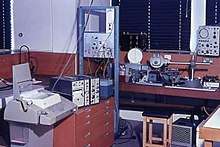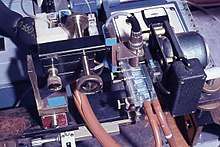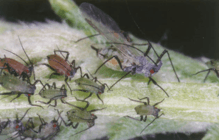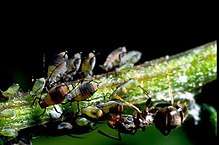Hugh Loxdale
Hugh David Loxdale D.Phil., FLS, Hon. FRES, FRSB, MBE (born 9 September 1950) is an entomologist, professor of ecology at the Institute of Ecology, University of Jena from 2009 to 2010, president of the Royal Entomological Society from 2004 to 2006, the society's honorary treasurer from 2011 to 2016, and honorary visiting professor at the School of Biosciences, Cardiff University from 2015 to 2020. Loxdale works on the population biology, ecology, and genetics of insects, especially aphids and their wasp parasitoids. Besides his scientific studies, he is also a poet, having written ten volumes of poetry since 1988, as well as a genealogist and is keen on classical music.
Hugh Loxdale | |
|---|---|
 Hugh Loxdale at Utting, Bavaria in September 2016 |
Early life
Loxdale was born in Horley, Surrey, England, on 9 September 1950, the second eldest child of three sons and two daughters born to Phyllis Marjorie Loxdale, née Duke (1921–1970) and John David (‘Jack’) Loxdale (1916–1993). He was named Hugh by his mother in honour of her late brother, Major Hugh Victor Duke (1918–1944), MC & Bar of the Devonshire Regiment, killed on D-Day, 6 June 1944.[1] In the early 1950s, his parents moved to Hemel Hempstead in Hertfordshire where he grew up.


His mother was born at Lezayre on the Isle of Man and later served from 1941 to 1946 in the Women's Auxiliary Air Force (WAAFs) as a Morse operator in a Royal Australian Air Force Sunderland Squadron stationed at Mount Batten Base, Plymouth.[2] His father, a manufacturing optician born in Hampstead, London, joined the Royal Naval Volunteer Reserve (RNVR) at the outbreak of the Second World War in 1939, later serving in the Merchant Service and finally in Royal Navy motor torpedo boats (MTBs) patrolling the Channel at the end of the war.
Education and career
Hugh Loxdale was educated at Corner Hall Secondary Modern Boys’ School, Hemel Hempstead, Hertfordshire, England from 1962 to 1967, and Apsley Grammar School, Hemel Hempstead (now Longdean School) from 1967 to 1969. On leaving school, he joined the Entomology Department at Rothamsted Experimental Station (now Rothamsted Research), in Harpenden, Hertfordshire, working in the Insect Survey, then run by L.R. (Roy) Taylor (1924–2007),[3] studying the demography of moths and aphids as part of the national light trap and 12.2-metre-high (40 ft) suction trap surveys, respectively.[4]
Scientific contribution
During his time at Oxford, Loxdale designed and development a continuous, circulatory NADH+-coupled enzyme ADP assay system which allowed for the first time accurate measurement of pico-mole quantities of ADP released from small bundles of glycerol-extracted fibres (c. 60μm diam.; c. 1.2 cm. long) during activation by threshold calcium ion concentration [Ca2+] and stretch activation of fibrillar insect flight muscle (IFM), or [Ca2+] activation of vertebrate skeletal muscle; meanwhile the mechanical performance of the fibres could be simultaneously measured by oscillating them at a range of frequencies and amplitudes[5][6]. From this, he was able to demonstrate that, contrary to theory, the tension cost (ratio of ATPase activity over tension) did not change markedly as a function of the level of activation, i.e. the ATPase versus tension relationships remained essentially constant.[7] It was thus concluded that the rate constant of detachment of myosin from actin during the acto-myosin cross bridge cycle was not, as hitherto assumed, more especially for fibrillar IFM, the rate-limiting step in determining contraction speed of the muscle. Indeed, he was able to demonstrate using ATP solutions buffered with phosphate ions, that the tension cost and mechanical performance could even be dissociated from one another. In light of these findings, Roger H. Abbott formulated a four-state cross bridge cycle as most adequately accounting for the phenomena observed.[8] In addition, using glycerol extracted rabbit psoas muscle fibres activated in the absence of threshold concentrations of calcium ions using reduced ionic strength, Loxdale was also able to demonstrate that magnesium ions are necessary to stabilize the troponin-tropomyosin regulatory system, i.e. maintain this in the non-activated condition.[9]



In terms of his insect population genetics studies, Loxdale in collaboration with Cliff Brookes, was the first to demonstrate at Rothamsted, using single locus polymorphic allozyme markers, that as with birds, different aphid species had different migratory urges and abilities as a consequence of their innate migratory behaviours (a notion supported by wind tunnel experiments performed at the Imperial College Field Station at Silwood Park, Ascot, by Professor Jim Hardie and colleagues).[10][11] In comparative studies performed over many years, later involving polymorphic microsatellite markers and a range of aphid species (Hemiptera: Aphididae), both pest and non-pest, it was revealed that some species such as the grain aphid, Sitobion avenae (F.), a predominantly asexual pest of cereals in Europe and elsewhere, did indeed appear capable of travelling long distances[12][13] In contrast, other species like the closely related blackberry-grain aphid, S. fragariae (Walker), a host alternating species with an autumn-winter sexual life cycle phase (i.e. the sexual females, on mating, laying cold hardy eggs), only travelled mainly short distances, perhaps less than 30 km.[14] Other species still, including the host alternating damson-hop aphid Phorodon humuli (Schrank)[15] and two species of non-host alternating tansy-feeding aphid − Macrosiphoniella tanacetaria (Kaltenbach) and Metopeurum fuscoviride Stroyan − also showed local dispersal behaviours.[16] Such data has considerable relevance to efforts to control aphid pests, globally amongst the most serious insect pests of many cash crops, more especially due to their ability to transmit pathogenic plant viruses of various kinds.[17] This work has been extensively reviewed in various publications, e.g.[18][19]


Loxdale and colleagues were also the first to demonstrate from their studies conducted in Jena that in the tansy aphid M. fuscoviride parasitized by its specialist wasp parasitoid Lysiphlebus hirticornis Mackauer (Hymenoptera: Braconidae), as the local genetic variation of the aphid increased, so did that of its parasitoid. This suggested a fine-grained co-evolutionary tracking to be in operation.[20] Such a scenario is supportive of the Red Queen hypothesis,[21] whereby a host organism (here an aphid) is attempting to evolve away from its antagonist (here a parasitoid), which is meanwhile co-evolving in order to retain the ability to attack it, i.e. keep pace with it in an ecological-evolutionary sense. Loxdale, in collaboration with G.M. Tatchell at Rothamsted, were also the first to determine the insecticide resistance status (here conferred by carboxylesterases, i.e. R1, R2 and R3 genotypes) of the serious agricultural pest the peach-potato aphid, Myzus persicae (Sulzer) captured in the UK network of 12.2. m high suction traps.[22] This involved using pH-buffered glycerol solutions containing antibiotic and gel electrophoresis to identify the level of carboxylesterase gene expression of the individual genotypes (the result of amplification of the E4 and FE4 resistance genes involved)[23][24] From this work, the spatial and temporal dynamics of this important (and now highly cross-resistant) pest aphid could be followed, thereby leading to more rational and effective control measures in the field.
With moths, Loxdale and his then PhD student Ian R. Wynne, were able to show using polymorphic allozyme markers, that in local populations of the November moth Epirrita dilutata (Denis & Schiffermüller) (Lepidoptera: Geometridae) inhabiting fragmented woodlands within the agro-ecosystem of the Rothamsted estate (330 ha), little inter-population gene flow was found to occur, even at distances of only a few kilometres. From these findings, it was concluded that the moths, which seemingly displayed high levels of habitat fidelity, possessed an innate reluctance to fly over flat, cultivated farmland. This study, here on a model Lepidopteran species, emphasizes the importance and utility of such genetic markers, even at a very local geographic scale, in studies of natural insect populations, both for purpose of conservation or control.[25]
Loxdale has written a series of overviews, many with colleagues, especially Dr. G. Lushai, highlighting the improbability of strict genetic uniformity in populations of clonal organisms such as aphids. This lack of uniformity is due to the rapid rate of mutation resulting from various mechanisms (e.g. point mutations due to errors of replication, inversion polymorphisms related to transposon effects, etc.) amplified by the huge reproductive potential of the animals concerned, e.g., not only do aphids show ‘telescoping of generations’ such that an adult asexual female has her children and grandchildren within her, but also display so-called ‘genetic inflation’, i.e. the production of a large number of asexual copies produced by a single female (10-100 offspring) in a short time (~ 10-14 days). Hence, a single aphid can, in theory (i.e. without mortality factors such as climate, predators, parasitoids and pathogens) produce enough offspring to cover the entire planet to a depth of many kilometres in a single growing season![26] This of course has serious potential consequences for the agricultural, horticultural and forestry industries worldwide.[27]
Aphids are known to show much variation − morphological, genetic, behavioural, etc. − which emphasizes the fact that they need to evolve quickly in the face of continuously developing ecological-evolutionary pressures and selective regimes (like the use of new kinds of insecticides), and hence need to be highly adaptive, rather than ecologically stagnant, i.e. living as large-scale clonal copies spread over wide geographic areas and persisting for long periods of time. Although some aphids such as M. persicae do show some insecticide resistant genotypes of this type,[28] these are maintained within the cultivated and manicured agro-ecosystem, hardly the real world in a long-term ecological sense.
In relation to theory, Loxdale & Lushai proposed in 2007 that the sexual cycle of aphids, rather than obligate asexuality, might be due to the necessity of telomere re-setting of the end of the chromosomes.[29][30] ["A telomere is a region of repetitive nucleotide sequences at each end of a chromosome, which protects the end of the chromosome from deterioration or from fusion with neighboring chromosomes."; see Wikipedia for further details]. If such telomere re-setting does not occur, then, as the authors posit, the asexual lineages will become non-adaptive and die out as a function of transgenerational telomere shortening, a so-called aphid clone being, in effect, some kind of transgenerational entity, persisting (or so it was earlier believed) genetically unchanged over many generations
Critics of this theory[31][32] point out that telomere length in aphids is not highly regulated as it is in vertebrates (especially mammals), may occur even in the parthenogenetic phase of reproduction, and apparently aphid species colonies kept in culture over very many asexual generations (accepting something like 20 asexual generations per annum) have long telomere lengths. However, as is known, aphids can produce sexual forms (males and sexual females = oviparae) from time to time, even on secondary herbaceous hosts, when environmental stimuli are favourable, i.e. reduced light and temperature. Thus, it is possible that unless culture conditions are strictly maintained, some cryptic sexual reproduction may continue and hence some telomere re-setting occasionally occur.
In empirical studies of aphid chromosomes Loxdale, Lushai and colleagues were also able to demonstrate using RAPD (random amplified polymorphic DNA) markers that in asexual lineages (= 'clones' sensu lato) of cereal aphids (S. avenae and the bird cherry-oat aphid, Rhopalosiphum padi (L.)) maintained under strict conditions of rearing hygiene (i.e. each lineage was founded from a single parthenogenetic adult female reared on individual barley leaves in separate net-covered glass tubes standing in water), intra-clonal, trans-morph (sexual vs. asexual, winged vs. wingless) genetic changes were seen to occur. These may relate to changes in the RAPD primer binding sites in turn due perhaps to transposon effects.[33][34] At the chromosome level, recent studies by Loxdale in collaboration with Professor G. Manicardi, Dr. V. Monti and colleagues have demonstrated the existence of intra-clonal, inter-embryo genetic variation in terms of chromosome karyotype within individuals, and within and between clones of M. persicae.[35] Studies with both RAPDs and AFLPs (amplified fragment length polymorphic DNA) have also shown that aphid clones display both somatic and germline mutational changes within a few generations.[36] Hence the aphid clone is a very dynamic entity[37], not an invariant one as hitherto believed.
Loxdale has also written overviews on several key areas of biological thought and research. These include the migration and dispersal of insects in relation to their genotype and habitat[38]; intra-clonal genetic variation[39]; rapid evolution in insect populations due to various genetic-ecological mechanisms[40]; population proteomics (with Dr David Biron, Prof. Frédéric Thomas and colleagues)[41]; and most recently, on the improbability of generalism in nature, with special reference to insects, work in collaboration with G. Lushai and Professor Jeffrey Harvey.[42][43] The consensus of these articles is that the act of filling a new ecological niche is of course the fundamental act of specialization for any new species or sub-specific population. Whilst some species may be polyphagous to varying degrees, which the authors define, nevertheless diet breadth tends to involve preference for certain prey items in predatory as well as herbaceous species. Generalism, if it exists, is highly dependent upon an animal's morphology-anatomy, genetics, physiology-biochemistry, and chemistry, especially chemical ecology. This in turn governs the behaviour of the animal concerned and restrains it in terms of its habitat choice and what it can eat. In this light, the age old ‘arms race’ of insect herbivores with plants has led to the plants evolving an armoury of secondary chemical defenses which cause, more often than not, specialisms in terms of host and indeed habitat on the part of the herbivore/s involved. Ultimately, even apparently highly polyphagous species such as the aphid M. persicae, said to attack plants in 40 families,[44] may be because of its highly specialised biochemistry-enzymology. Most aphids are highly specialised on one host or closely related hosts (often in the same genus/family)[45], probably due to biochemical constraints, and if so, perhaps what one is seeing in M. persicae is a unique specialization rather than generalization.[46]
The picture is also complicated by the recent discovery in many species, including M. persicae and other aphids, following the application of high-resolution molecular markers, of morphologically similar/identical cryptic species. The discovery and realization of such cryptic entities is essential for successful pest control, especially including use of natural control agents such as hymenopterous wasp parasitoids and predators, as well as for the conservation of rare and endangered species.[47]
In terms of Loxdale's proteomics studies with Biron and colleagues in France, these have shown that nematomorph worms parasitizing crickets and grasshoppers (Orthoptera) cause fundamental neurological changes in the brain of their hosts. This induces the host to seek water and effectively commit suicide by jumping into it, whereupon the adult worm exits the host and seeks a mate and the females so mated then lay eggs to complete the life cycle.[48]
Recently, Loxdale has published an overview on the decline of entomological studies, especially in the UK, as a result of cutbacks in government and other funding sources. This problem not only seriously impacts directly on the importance of such studies in the fields of agriculture, horticulture, forestry, medicinal, veterinary and conservation studies, but also on the membership of the learned societies supporting entomology and the careers of those seeking long-term employment in this vital discipline.[49]
Poetry
Loxdale has written over 500 poems in a variety of styles over the last 50 years or so, mainly on natural history themes, often with a philosophical slant. His first poem, Dragonfly, was published whilst he was still at Apsley Grammar School (now Longdean) in the late 1960s. To date he has published ten volumes of his poetry (as below), including one for children, Zoooo[50], whilst many poems have been published in books and magazines, on the www and the BBC website (e.g. his poem Across this Land, an epic poem on the destruction of the English countryside as a result of overzealous road construction). Because the author is a scientist, he tends to embrace realism in his poetic endeavours, having a duty, as he feels, to tell ‘it as it is’, even about such beloved and iconic animals as cats and dogs.
Fascinating Felines (2002)
ISBN 9780954334703
The Eternal Quest: A celebration of nature in poetry (2003) ISBN 9780954334710
Blue Skies in Tuscany (2003) ISBN 9780954334727
Bird Words: Poetic images of wild birds (2003) ISBN 9780954334734
The Jena Poems (2010) ISBN 9780955392894
Love and the Sea (2010) ISBN 9780955392887
Nevisian Days: Poetry from a Caribbean Isle (2011) ISBN 9781908241009
Bird of Paradise: Selected Poems, 1968-2011 (2011) ISBN 9781908241016
Zoooo…Living Poems for Children (2012) ISBN 9781908241139
Red Tulips, Selected Poems, 1999-2016 (2017) ISBN 9781908241511
Personal Life
Loxdale has been married for 27 years to Nicola von Mende, PhD, molecular nematologist and latterly, publisher of natural history books.


References
- "Casualty".
- "Coastal Command and Maritime Air Association, Contributions".
- Taylor, Robin A. J. (2007). "Obituary: Roy (L. R.) Taylor (1924-2007)". Journal of Animal Ecology. 76 (3): 630–631. doi:10.1111/j.1365-2656.2007.01243.x.
- Harrington, R. (2014) The Rothamsted Insect Survey strikes gold. Antenna 38, 159–166.
- Loxdale, H.D. (1980) Molecular parameters of diverse muscle systems. DPhil thesis, University of Oxford.
- Loxdale, H.D. (1976) A method for the continuous assay of picomole quantities of ADP released from glycerol-extracted skeletal muscle fibres on MgATP activation. Journal of Physiology 260, 4-5.
- Loxdale, H.D. & Tregear, R.T. (1985) Dissociation between mechanical performance and the cost of isometric tension maintenance in Lethocerus flight muscle. Journal of Muscle Research & Cell Motility 6, 163-175.
- Abbott, R.H. (1977) The relationship between biochemical kinetics and mechanical properties. 269-273. In: Insect Flight Muscle (ed. by R.H. Tregear), Proceedings of the Oxford Symposium, 3rd-5th April, 1977. North-Holland Publishing Company, The Netherlands. Pp. 367.
- Loxdale, H.D. & Tregear, R.T. (1983) Generation of tension by glycerol-extracted vertebrate skeletal muscle fibres in the absence of calcium. Journal of Muscle Research & Cell Motility 6, 543-556.
- Loxdale, H.D., Hardie, J. Halbert, Susan, Foottit, R., Kidd, N.A.C. & Carter, C.I. (1993) The relative importance of short- and long-range movement of flying aphids. Biological Reviews 68, 291-311.
- Hardie, J. (1993) Flight behaviour in migrating insects. Journal of Agricultural Entomology 10, 239–245.
- Loxdale, H.D., Tarr, I.J., Weber, C.P., Brookes, C.P., Digby, P.G.N. & Castañera, P. (1985) Electrophoretic study of enzymes from cereal aphid populations. III. Spatial and temporal genetic variation of populations of Sitobion avenae (F.) (Hemiptera: Aphididae). Bulletin of Entomological Research 75, 121-141.
- Llewellyn, K. S., Loxdale, H.D., Harrington, R., Brookes, C.P., Clark, S.J. & Sunnucks, P. (2003). Migration and genetic structure of the grain aphid (Sitobion avenae) in Britain related to climatic adaptation and clonal fluctuation revealed using microsatellites. Molecular Ecology 12, 21-34.
- Loxdale, H.D. & Brookes, C.P. (1990) Genetic stability within and restricted migration (gene flow) between local populations of the blackberry-grain aphid Sitobion fragariae in south-east England. Journal of Animal Ecology 59, 495-512.
- Loxdale, H.D., Brookes, C.P., Wynne, I.R. & Clark, S.J. (1998) Genetic variability within and between English populations of the damson-hop aphid, Phorodon humuli (Hemiptera: Aphididae), with special reference to esterases associated with insecticide resistance. Bulletin of Entomological Research 88, 513-526.
- Loxdale, H. D., Schöfl, G., Wiesner, K.R., Nyabuga, N.N., Heckel, D.G. & Weisser, W.W. (2011) Stay at home aphids: comparative spatial and seasonal metapopulation structure and dynamics of two specialist tansy aphid species studied using microsatellite markers. Biological Journal of the Linnean Society 104, 838–865.
- Katis, N.I., Tsitsipis, J.A., Stevens, M. & Powell, G. (2007) Transmission of plant viruses. In: Aphids as Crop Pests (ed. by H.F. van Emden & R. Harrington), pp. 353–390. CABI, Wallingford, Oxford, UK.
- Loxdale, H.D. & Lushai, G. (2007) Population genetic issues: the unfolding story revealed using molecular markers. In: Aphids as Crop Pests (ed. by H.F. van Emden & R. Harrington), pp. 31-67. CABI, Wallingford, Oxford, UK.
- Loxdale H. D., Edwards, O., Tagu, D. & Vorburger C. (2017) Population genetic issues: new insights using conventional molecular markers and genomics tools. In: Aphids as Crop Pests, 2nd edn. (eds. H.F. van Emden & R. Harrington). pp 50-80, CABI, Wallingford, Oxford, U.K.
- Nyabuga, F.N., Loxdale, H.D., Heckel, D.G. & Weisser, W. W. (2012) Coevolutionary fine-tuning: evidence for genetic tracking between a specialist wasp parasitoid and its aphid host in a dual metapopulation interaction. Bulletin of Entomological Research 102, 149 – 155.
- van Valen, L. (1973) A new evolutionary law. Evolutionary Theory 1, 1–30.
- Tatchell, G.M., Thorn, M., Loxdale, H.D. & Devonshire, A.L. (1988) Monitoring for insecticide resistance in migrant populations of Myzus persicae. In: Proceedings of Brighton Crop Protection Conference - Pests & Diseases - 1988. 439-444.
- Foster S.P., Harrington, R., Dewar, A.M., Denholm, I. & Devonshire, A.L. (2002) Temporal and spatial dynamics of insecticide resistance in Myzus persicae (Sulzer). Pest Management Science 58, 895–907.
- Loxdale, H.D. (2009) What’s in a clone: the rapid evolution of aphid asexual lineages in relation to geography, host plant adaptation and resistance to pesticides. Pp. 535-557 in: Lost Sex: The Evolutionary Biology of Parthenogenesis, (ed. by Isa Schön, Koen Martens & P.J. van Dijk), Springer-Verlag, Berlin.
- Wynne, I.R., Loxdale, H.D., Brookes, C.P. & Woiwod, I.P. (2003) Genetic structure of fragmented November moth (Lepidoptera: Geometridae) populations in farmland. Biological Journal of the Linnean Society 78, 467-477.
- Harrington, R. (1994) Aphid layer (letter). Antenna 18, 50.
- Loxdale, H.D. (2016) Insect biology - a vulnerable discipline? Entomologia Experimentalis et Applicata 159, 121–134.
- Fenton, B., Margaritopoulos, J.T., Malloch, G.L. & Foster, S.P. (2010) Micro-evolutionary change in relation to insecticide resistance in the peach–potato aphid, Myzus persicae. Ecological Entomology 35, 131–146.
- Loxdale, H.D. & Lushai, G. (2003) Maintenance of aphid clonal lineages: images of immortality. Infection, Genetics & Evolution 3, 259-269.
- Lushai, G. & Loxdale, H.D. (2007) The potential role of chromosome telomere resetting consequent upon sex in the population dynamics of aphids: an hypothesis. Biological Journal of the Linnean Society 90, 719-728.
- Monti V., Giusti, M., Bizzaro, D., Manicardi, G. C. & Mandrioli M. (2011) Presence of a functional (TTAGG)n telomere-telomerase system in aphids. Chromosome Research 19, 625–633.
- Monti, V., Mandrioli, M., Rivi, M. & Manicardi, G. C. (2012) The vanishing clone: karyotypic evidence for extensive intraclonal genetic variation in the peach-potato aphid, Myzus persicae (Hemiptera: Aphididae). Biological Journal of the Linnean Society 105, 350–358.
- Lushai, G., Loxdale, H.D., C.P. Brookes, von Mende, Nicola, Harrington, R. & Hardie, J. (1997) Genotypic variation among different phenotypes within aphid clones. Proceedings of the Royal Society, Series B 264, 725-730.
- Loxdale, H.D. & Balog, A. (2018) Aphid specialism as an example of ecological-evolutionary divergence. Biological Reviews 93, 642-657. doi: 10.1111/brv.12361
- Monti, V., Lombardo, G., Loxdale, H.D., Manicardi, G.C. & Mandrioli, M. (2012) Continuous occurrence of intra-individual chromosome rearrangements in the peach potato aphid, Myzus persicae (Sulzer) (Hemiptera: Aphididae). Genetica 140, 90-103.
- Loxdale, H.D., Vorwerk, S. & Forneck, A. (2013) The unstable 'clone': evidence from monitoring AFLP-based mutations for short-term clonal genetic variation in two asexual lineages of the grain aphid, Sitobion avenae (F.). Bulletin of Entomological Research 103, 111-118.
- Lushai, G., Loxdale, H.D. & Allen, J. A. (2003) The dynamic clonal genome and its adaptive potential. Biological Journal of the Linnean Society 79, 193-208.
- Loxdale, H.D. & Lushai, G. (1999) Slaves of the environment: the movement of insects in relation to their ecology and genotype. Philosophical Transactions of the Royal Society, Series B, Biological Sciences 354, 1479–1495.
- Loxdale, H.D. & Lushai, G. (2003) Rapid changes in clonal lines: the death of a ‘sacred cow’. Biological Journal of the Linnean Society 79, 3-16.
- Loxdale, H.D. (2010) Rapid genetic changes in natural insect populations. Ecological Entomology (special issue) 35, 155-164.
- Biron, D.G., Loxdale, H.D., Ponton, F., Moura, H., Marché, L., Brugidou, C. & Thomas, F. (2006) Population proteomics: an emerging discipline to study metapopulation ecology. Viewpoint article. Proteomics 6, 1712–1715.
- Loxdale, H.D., Lushai, G. & Harvey, J.A. (2011) The evolutionary improbability of ‘generalism’ in nature, with special reference to insects. Biological Journal of the Linnean Society 103, 1-18.
- Loxdale, H.D. & Harvey, J.A. (2016) The ‘generalism’ debate: misinterpreting the term in the empirical literature focusing on dietary breadth in insects. Biological Journal of the Linnean Society 119, 265–282.
- Blackman, R. L. & Eastop, V. F. (2000) Aphids on the World’s Crops: An Identification and Information Guide, Second Edition, John Wiley & Sons Ltd., Chichester.
- Loxdale, H.D. & Balog, A. (2018) Aphid specialism as an example of ecological-evolutionary divergence. Biological Reviews 93, 642-657. doi: 10.1111/brv.12361
- Mathers, T. C., Chen, Y., Kaithakottil, G., Legeai, F., Mugford, S. T., Baa-Puyoulet, P., Bretaudeau, A., Clavijo, B., Colella, S., Collin, O., Dalmay, T., Derrien, T., Feng, H., Gabald´on, T., Jordan, A., et al.(2017) Rapid transcriptional plasticity of duplicated gene clusters enables a clonally reproducing aphid to colonise diverse plant species. Genome Biology 18, 27. https://doi.org/10.1186/s13059-016-1145-3.
- Loxdale, H.D., Davis, B.J. & Davis, R.A. (2016). Known knowns and unknowns in biology. Biological Journal of the Linnean Society 117, 386–398. doi: 10.1111/bij.12646
- Biron, D.G., Marché, L., Ponton, F., Loxdale, H.D., Galéotti, N., Renault, L., Joly, C. & Thomas, F. (2005) Behavioural manipulation in a grasshopper harbouring hairworm: a proteomics approach. Proceedings of the Royal Society, Biological Sciences 272, 2117–2126.
- Loxdale, H.D. (2016) Insect biology - a vulnerable discipline? Entomologia Experimentalis et Applicata 159, 121–134.
- https://hughloxdalepoetry.co.uk/home
External links
Who’s Who, 2005 to present Who’s Who online, 2007 to present